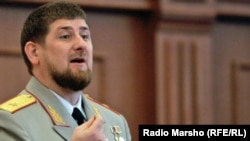Four young men from the Chechen village of Kurchaloi suspected of an arson attack on the mausoleum of a Sufi saint are being subjected to organized vilification by local residents at the behest of Chechen Republic head Ramzan Kadyrov -- and with his active encouragement.
The men are said to have confessed to pouring gasoline over the tomb in Kurchaloi of Sheikh Yangulby, a disciple of the venerated 19th-century Sufi saint Kunta-hadji, from whom Kadyrov claims to be descended, and setting it alight. The blaze was swiftly extinguished. Kadyrov quoted the perpetrators as having said they were motivated by listening to “sermons of extremist content” on the Internet.
Speaking on Chechen state television on November 17, the day after the incident, Kadyrov accused the young men of having links to fighters in Syria and declared that they and their families “should be cursed.”
It was the second arson attack on a Sufi shrine in Chechnya in less than two months. The first took place during the night of October 9-10, when the mausoleum of Sheikh Durdi, also a disciple of Kunta-hadji, was set alight in a cemetery in Shali.
No one was apprehended in connection with that incident, and Kadyrov did not comment on it publicly, even though, as unnamed representatives of Chechnya’s Muslim Spiritual Board pointed out, it was the first such act of vandalism since the Bolsheviks set about suppressing religious belief in the 1920s.
It is conceivable that the October attack, which reportedly gave rise to widespread rumors and speculation, may have been perpetrated in order to create a pretext for harsher reprisals against young men suspected of preferring the more orthodox Salafi Islam espoused by the North Caucasus insurgency to Kadyrov’s own idiosyncratic take on Chechen Sufism, which one young militant characterized disparagingly as “a hodgepodge of Sufi fairy tales and local adats (traditional precepts).”
Kadyrov’s understanding of “traditional Chechen Islam” -- as distinct from the canonical Sunni Islam represented by the Shafii legal school that co-exists with it in Chechnya -- encompasses and encourages the veneration of Sufi saints and pilgrimages to their shrines, of which there are said to be some 130 in Chechnya.
Since the October incident in Shali, there have been numerous reports of the mass detention of young men who aroused the suspicion of security personnel by wearing beards but shaving their upper lip, Salafi-style.
There is no way of knowing whether the Kurchaloi episode was a copycat attack inspired by the earlier act of arson in Shali, or whether both were the work of young Salafi sympathizers.
The four young suspects were forced to appear at three separate public meetings on November 18, in Kurchaloi and the nearby villages of Geldagan and Mayrtup, and further such public meetings are planned, according to a member of Chechnya’s Muslim Spiritual Board.
It is not clear whether the young men have been formally charged under the Russian Criminal Code (Article 214) with group vandalism, which carries a possible sentence of up to three years’ imprisonment. It further remains to be seen whether, after submitting them to repeated ritual humiliation, Kadyrov will see fit to demonstrate magnanimity by pardoning them, as he recently did a group of young men publicly accused of plotting his assassination.




